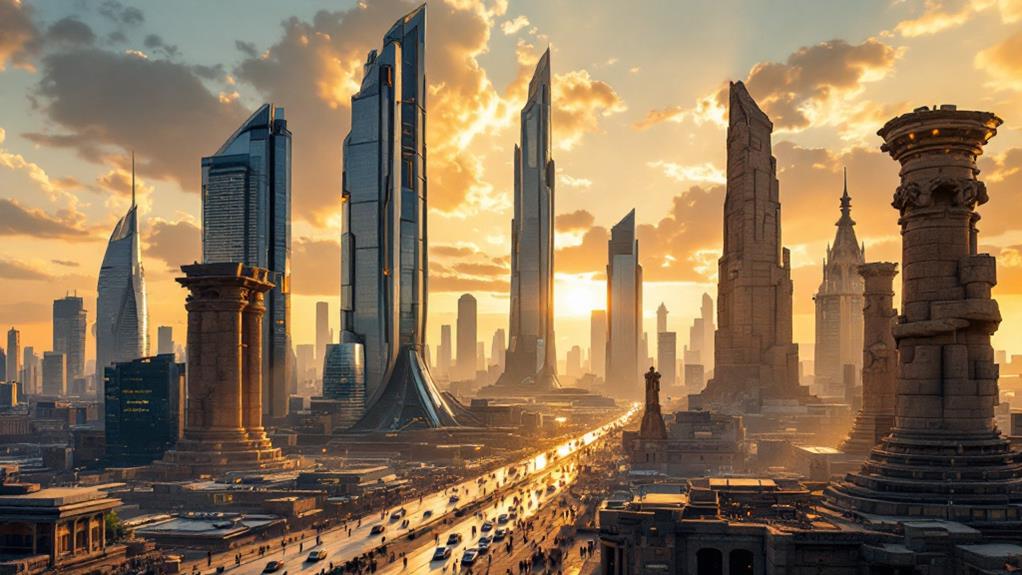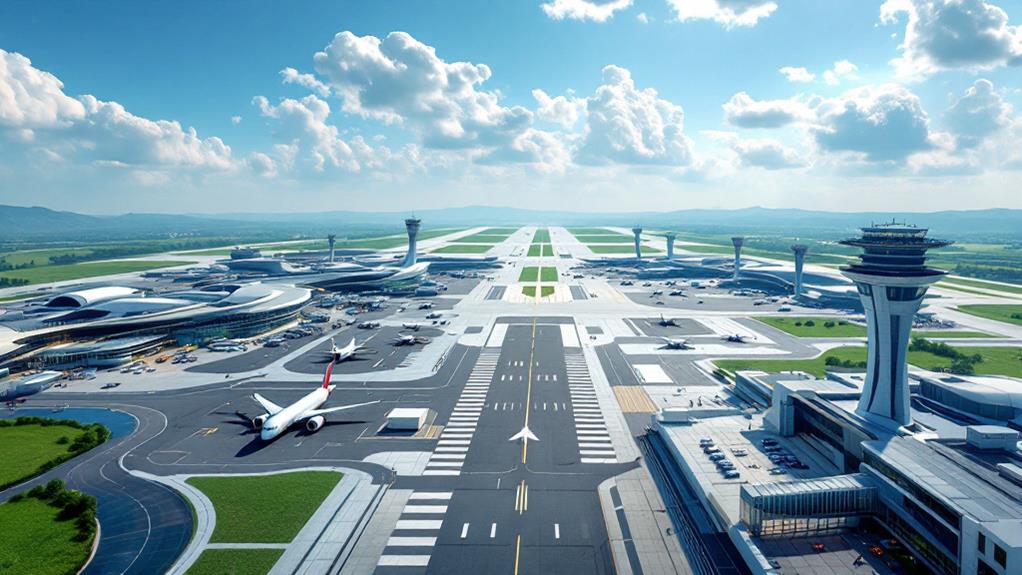The Tallest and Largest Buildings Ever Constructed

When you think of the tallest and largest buildings ever constructed, the Burj Khalifa stands tall at 828 meters, showcasing incredible engineering feats. For sheer volume, the Boeing Everett Factory takes the crown with its vast space of 13.3 million cubic meters. Historically, the Great Pyramid of Giza and the Lincoln Cathedral were marvels of their time, holding the title of tallest structures. In the domain of enormous floor space, the Chengdu New Century Global Center leads with its sprawling 1.76 million square meters. These structures represent human ambition and innovation, and there's plenty more to uncover beyond their grandeur.
Largest Buildings by Volume
In regards to the largest buildings by volume, the Boeing Factory in Everett, WA, USA, undeniably stands out with its immense volume of 13.3 million m³ (472 million cu ft). You can't help but be amazed by the sheer scale of construction and capacity it offers. This factory is a hub of aviation innovation, assembling some of the world's most advanced aircraft. Its massive dimensions accommodate numerous production lines and vast storage areas.
Moving across the globe, the Aerium in Halbe, Germany, boasts the largest uninterrupted volume at 5.2 million m³ (184 million cu ft). Originally a hangar, it's now a tropical resort, emphasizing the versatility such enormous spaces can provide.
In the U.S., the Gigafactory Texas in Austin spans 9.57 million m³ (338 million cu ft) and stretches across 16 city blocks. It's a demonstration of modern industrial capabilities.
In Toulouse, France, the Jean-Luc Lagardère Plant, dedicated to assembling the Airbus A380, has a volume of 5.6 million m³ (199 million cu ft), showcasing European aerospace prowess.
Lastly, NASA's Vehicle Assembly Building at Kennedy Space Center, with a capacity of 3.66 million m³ (130 million cu ft), highlights its vital role in space exploration since its construction for Saturn V rockets.
Historical Tallest Structures
Just as the largest buildings by volume impress with their sheer size, historical tall structures captivate with their monumental heights and the stories they tell of human ambition. The Great Pyramid of Giza, completed around 2550 B.C., stood as the tallest structure in the world for nearly 4,000 years. Its height of 455 feet (originally 481.4 feet before erosion) set a standard for future manmade structures.
Fast forward to 1311, the Lincoln Cathedral in England emerged as the tallest building, soaring to 525 feet. This Gothic architecture marvel held the title until 1548. The Cathedral of Our Lady of Strasbourg then claimed the spotlight from 1647 to 1874, reaching a height of 465.9 feet, admired by luminaries like Victor Hugo and Goethe.
The Washington Monument, completed in 1884, was next, towering at 555.4 feet. Its unique construction in two phases with different marbles marked a significant achievement in architectural history.
Finally, the Willis Tower in Chicago, completed in 1973, claimed its place as the world's tallest building until 1996 with a height of 1,450 feet.
- Great Pyramid of Giza: Tallest for 4,000 years
- Lincoln Cathedral: Gothic architecture at 525 feet
- Cathedral of Our Lady of Strasbourg: 465.9 feet
- Washington Monument: 555.4 feet, built in two phases
- Willis Tower: 1,450 feet, world's tallest until 1996
Modern Skyscraper Trends

Modern skyscrapers aren't just about reaching new heights; they're redefining how we use urban spaces. You're witnessing the rise of mixed-use tall buildings, where living, working, and leisure coexist under one roof. By 2010, less than half of the 100 tallest buildings were primarily offices, reflecting a shift towards multifunctionality. This evolution isn't just about space, it's also about sustainability. Creative features like vertical gardens and energy-efficient designs are becoming standard. These elements not only reduce environmental impact but also improve the quality of urban life.
In today's world, the trend of "supertall" and "megatall" skyscrapers is most prominent in Asia, which now boasts 60 of the world's 100 tallest buildings. This marks a decline in North America's lead in this category. The Burj Khalifa, standing at a staggering 828 meters, exemplifies the pinnacle of modern architectural advancements and height records. It showcases advanced engineering techniques, such as composite structures, which push the limits of what's possible in skyscraper construction. As you look to the future, these modern skyscrapers will continue to stretch boundaries, integrating state-of-the-art technology with eco-friendly practices to shape sustainable urban landscapes.
Gigafactories and Aerospace Facilities
Gigafactories and aerospace facilities embody the future of large-scale industrial production, transforming how we manufacture vehicles and aircraft. Tesla's Gigafactory Texas, sprawling over 929,000 m² (10 million sq ft), stands as a demonstration to the scale and ambition of modern production hubs. It's equivalent to three Pentagons in size and is essential for electric vehicles and battery storage. Meanwhile, the Gigafactory in Nevada covers 455,000 m² (4.9 million sq ft), focusing on reducing battery cell costs through advanced automation.
In the domain of aerospace manufacturing, the Boeing Everett Factory in Washington takes the spotlight as the largest building in the world by volume, at 13.3 million m³ (472 million cu ft). It's where iconic commercial airplanes like the 747 and 787 are assembled. NASA's Vehicle Assembly Building in Florida, with a volume of 3.66 million m³ (130 million cu ft), underscores the monumental scale needed for space exploration, originally built for the Saturn V rockets.
Consider these incredible facts:
- Gigafactory Texas size: 929,000 m²
- Nevada's battery focus: Advanced automation
- Boeing's volume champion: 13.3 million m³
- NASA's colossal scale: 3.66 million m³
- Transformative impact: On manufacturing methods
These facilities show how large-scale production reshapes industries.
Major Airport Developments

Airports are the lively gateways to the world, and recent developments have transformed them into monumental hubs of connectivity. Beijing Daxing International Airport stands out with the world's largest satellite terminal, spreading across 700,000 square meters (7.5 million square feet). It's designed to enhance passenger capacity and streamline operations using the latest technologies. Istanbul Airport is another marvel, crafted as an international mega-hub with plans to cater to up to 200 million passengers annually when fully operational. This ambitious project aims to expand capacity and reinforce its status as a major global hub.
Dubai Airports exemplify continuous growth, with Dubai International Airport handling over 86 million passengers in 2019. It's all about improving passenger experience and staying at the forefront of airport developments. Meanwhile, Chengdu New Century Global Center, though primarily commercial, is significant for its role in major airport developments. As the largest building by total floor area at 1.76 million square meters (18.9 million square feet), it shows the scale of modern infrastructure projects.
These developments don't just focus on size. They emphasize efficiency, capacity expansion, and the integration of new technologies to guarantee seamless global connectivity.



